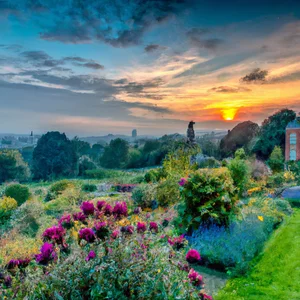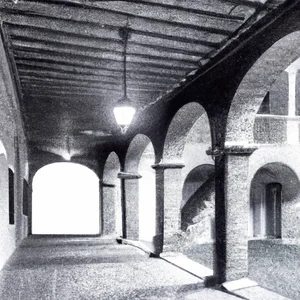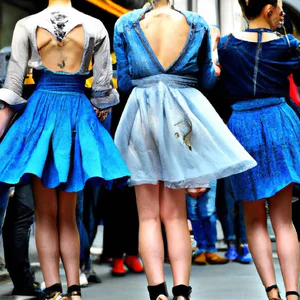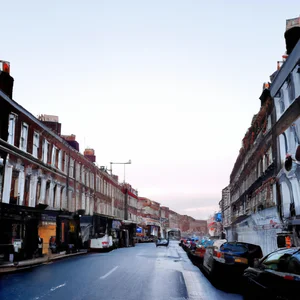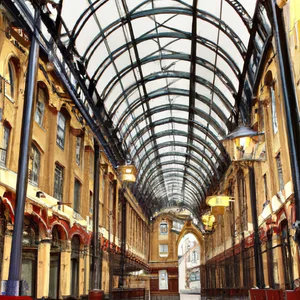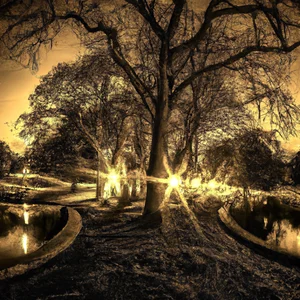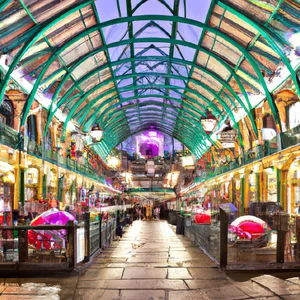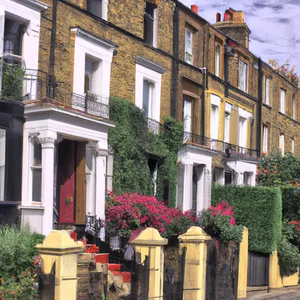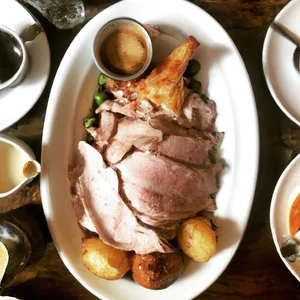Book your experience
Brixton: multiculturalism, markets and the music scene of South London
Brixton, oh, what a place! It’s like a mosaic of intertwining cultures, a real feast for the senses. If you go there, you immediately realize that it’s not just a neighborhood of London, it’s a world unto itself. The markets, then, are a gem. Imagine walking among the stalls, with the scents of spices enveloping you, a mix of curry and tropical fruit. I tell you, it’s like walking into a Middle Eastern bazaar, but with a London twist.
And the music? Oh, music is the beating heart of Brixton! Every corner you turn, there seems to be someone playing or singing. You should know that, once, I ended up in a pub, and although I wasn’t sure what to expect, I found a band playing live reggae. People were dancing like there was no tomorrow, and I, well, I tried to join in, even though my moves were more ’elephant in a glass shop’ than expert dancer. Laughing and joking, I realized that at that moment, there was no better place in the world.
Well, I think the true beauty of Brixton lies precisely in its diversity. People mingle, tell stories, and each face has something unique to offer. It may seem a little chaotic, but ultimately, that’s what makes it special. In short, if you’ve never been there, I recommend you give it a go. Maybe you will get lost among the markets, or maybe you will meet some street artists who will leave you speechless. I’m not sure, but I think a visit to Brixton could be an experience you won’t soon forget.
Discover the multiculturalism of Brixton: a unique journey
A personal experience
I still remember my first day in Brixton, getting off the tube and being greeted by an explosion of color and sound. The scent of spices from ethnic restaurants mixed with the pulsating rhythm of reggae music that hung in the air. Walking along Electric Avenue, the beating heart of the neighborhood, I noticed the smiling faces of people from all over the world. Every corner told a unique story, a mosaic of cultures that intertwine in a vibrant embrace.
Multiculturalism in numbers
Brixton is one of London’s most multicultural neighbourhoods, with over 50% of its population made up of ethnic minorities. Caribbean, African and South Asian communities have profoundly influenced the local culture, enriching the neighborhood with diverse traditions, cuisine and languages. According to Lambeth Council, this cultural melting pot is what makes Brixton such a special and vibrant place.
An insider tip
A little-known tip is to visit Brixton Market on Thursdays, when Brixton Village Street Food Thursdays takes place. Here, not only can you taste dishes from all over the world, but you also have the opportunity to speak directly with the vendors, listening to their stories and discovering the origins of their dishes. It’s a fantastic way to connect with the local community!
Cultural and historical impact
Brixton’s multiculturalism is not just a superficial feature; it is the result of decades of migration and integration. In the 1950s and 1960s, the neighborhood became a haven for many Caribbean immigrants, creating a strong sense of community and identity. This development has led to significant historical events, such as the Notting Hill Carnival celebrations, which have their roots in Brixton’s cultural heritage.
Sustainability and responsible tourism
Visiting Brixton also offers the opportunity to practice responsible tourism. Many of the local restaurants and markets adopt sustainable practices, using local and organic ingredients. Choosing to eat in these places means supporting the local economy and reducing the environmental impact.
Lively atmosphere and description
Walking through the streets of Brixton is like immersing yourself in a living canvas, where every color tells a story. The murals that grace the walls, the sounds of live music and the infectious energy of the people make this neighborhood an unforgettable experience. It is a place where the past and present meet, creating a unique atmosphere that invites discovery.
Recommended activities
Don’t miss the chance to visit Brixton Windmill, an old mill that offers guided tours and family activities. Here you can learn not only the history of the mill, but also how the local community works to preserve its heritage.
Myths and misconceptions
Often, Brixton is seen through a stereotypical lens, with prejudices portraying it as a dangerous place. However, anyone who visits the neighborhood will discover a welcoming and vibrant community, ready to share its culture and history. It is essential to dispel these myths, to allow more people to discover the beauty and richness of Brixton.
Final reflection
As you explore Brixton, ask yourself: how can different cultures coexist and enrich each other? The answer lies in every smile and every dish you taste, on a journey that goes beyond mere tourism, to become a celebration of life and of diversity.
Brixton markets: flavors and colors not to be missed
A journey into the senses
My first visit to Brixton Market was an experience that awakened all my senses. As I strolled through the stalls, the scent of exotic spices mixed with the aroma of freshly prepared local dishes. I remember standing in front of a jerk chicken vendor, watching the flames dance as the meat sizzled on the grill. I savored every bite of that spicy chicken, and I quickly realized that Brixton Market is not just a place to shop, but a true cultural journey.
Practical information
Brixton Market is open every day, but weekends are particularly lively with events and live performances. You can find a variety of fresh produce, street foods and artisanal items. One of the main attractions is Brixton Village, an indoor shopping center home to a myriad of ethnic restaurants and shops. I recommend you also visit Brixton Market, where you can find fresh ingredients and local products. For always up-to-date information, you can consult the market’s official website.
An insider tip
If you are a food lover, don’t miss the Salt Fish Bar, a small kiosk that serves the best fried fish in the area. This place is known only by locals and offers an authentic experience that will make you feel part of the community. Also, ask for their fish “festival”, a specialty you are unlikely to find elsewhere.
A profound cultural impact
Brixton Markets are not just a place of commerce; they are a testimony to the rich multiculturalism of the area. Since the 1960s, Brixton has welcomed migrants from all over the world, and this is reflected in the variety of foods and cultures present. The markets thus become a crossroads of stories and traditions, where each dish tells a piece of history of those who prepare it.
Sustainable tourism
Immersing yourself in Brixton’s markets is also an act of responsible tourism. Many vendors are committed to using local ingredients and sustainable practices. Choosing to buy fresh produce or street food not only supports the local economy, but also reduces environmental impact, contributing to a more sustainable community.
The beating heart of Brixton
Imagine strolling through the stalls, surrounded by bright colors and lively sounds, while savoring a sweet coconut caramel or a juicy mango. Every corner of Brixton Market is an explosion of life and culture. Here, you can savor not only the food, but also the vibrant energy of a community that celebrates diversity.
An experience from try
For an unforgettable experience, take a food tour of Brixton Markets. Many local tours offer the opportunity to discover the culinary secrets of the area, tasting typical dishes and meeting local producers. This is a great opportunity to deepen your knowledge of Brixton culture.
Myths to dispel
A common misconception about Brixton markets is that they are only for tourists. In reality, markets are a meeting point for the local community, a place where families come to shop and socialise. Don’t let the surface fool you: Brixton is a place where stories intertwine and traditions blend.
A final reflection
After visiting the markets of Brixton, you’ll find yourself reflecting on how food culture can bring people together. Which dish impressed you the most and which story would you like to take home? Brixton, with its rich tapestry of flavors and stories, offers a unique opportunity to explore the world through food.
Brixton’s music scene: from reggae to hip-hop
A journey through the notes of Brixton
I still remember the first time I set foot in Brixton, attracted not only by the vibrant multiculturalism of the neighbourhood, but also by its pulsating musical pulse. As I walked along Coldharbour Lane, the enveloping sound of reggae notes mixed with hip-hop rhythms, creating a unique harmony that told stories of hope and resilience. That evening, I stopped at a small venue, Hootananny, where a group of local artists were performing live. It was an experience that ignited in me a passion for the Brixton music scene, an emotional journey that continues to amaze me.
Practical and up-to-date information
Brixton is a musical epicenter that has produced many iconic artists, from David Bowie to Stormzy. Every year, Brixton Academy hosts internationally renowned concerts, while the neighborhood’s pubs and clubs offer evenings of live music ranging from reggae to grime. If you want an authentic experience, check out VisitBrixton.com, where you’ll find up-to-date information on events and concerts.
An insider tip
A little-known tip: don’t miss Brixton Jam, an underground club where you can discover emerging talent. Here, music is often accompanied by poetry events and artistic performances, creating an intimate and engaging atmosphere. It’s the ideal place to immerse yourself in local music culture and discover new artists before they become famous.
The cultural impact of Brixton
Brixton’s music scene isn’t just entertainment; it is a testimony to its social and cultural history. During the 1970s and 1980s, reggae and the sound system played a crucial role in giving voice to the Afro-Caribbean community, while in the 1990s hip-hop began to make inroads, reflecting the experiences and challenges of urban life. This musical evolution has helped shape Brixton’s identity, making it a place where music is a form of expression and a means of togetherness.
Responsible tourism practices
Discovering Brixton music can be a sustainable experience. Many venues use eco-friendly practices, such as reducing waste and using recycled materials. By opting for events that promote local, independent artists, you can contribute to a sustainable music economy and a greener future for the neighborhood.
Soak up the atmosphere
Imagine walking through the streets of Brixton at sunset, while the scent of spices mixes with the sound of guitars and voices rising in the bars. Every corner of the neighborhood tells a story, every note a tradition that is intertwined with the present. It is an experience that awakens the senses and invites discovery.
An activity worth trying
If you’re a music fan, don’t miss Brixton Village, where outdoor music events and jam sessions are often held. Here you can also taste typical dishes from all over the world, creating a perfect combination of food and music.
Myths and misconceptions
A common misconception is that Brixton is just a place of past and hardship. In reality, the music scene is a beacon of creativity and innovation, where artists of different origins come together to celebrate their diversity. Music in Brixton is a vital force that continues to evolve, challenging expectations and breaking stereotypes.
A final reflection
When you immerse yourself in the Brixton music scene, you realize that every note and every beat tells a story. What’s your favorite song that makes you feel like you’re part of something bigger? In this neighborhood, music isn’t just entertainment; it is a form of connection that brings people together through their shared experiences. You may discover that you too, through music, have a story to tell.
Local events: festivals that tell authentic stories
A personal experience
I vividly remember my first encounter with Brixton Splash, an annual festival celebrating the cultural diversity of this vibrant neighbourhood. As I walked through the colorful streets, surrounded by music, dance and the smells of delicious food, I felt part of a community telling stories through art, music and food. Every corner seemed alive, and in that moment I understood how deep the connection was between local events and Brixton’s identity.
Practical information
Brixton hosts a number of festivals throughout the year, each reflecting the community’s diverse cultures and traditions. As well as Brixton Splash, events such as Brixton Food Festival and Brixton Carnival offer a unique opportunity to immerse yourself in local life. To stay up to date on events, it is useful to follow the Brixton Buzz and Visit Brixton social pages, which provide timely and detailed information.
Unconventional advice
If you want a truly authentic experience, attend the Brixton Green Fair. It’s not just a festival, but an opportunity to meet local artisans and discover the sustainable practices that characterize the neighborhood. Here you can find organic and artisanal products, all while hearing fascinating stories directly from those who live and work in Brixton.
Cultural and historical impact
These festivals are not just celebrations, but a way to preserve and pass down stories that date back generations. The multiculturalism of Brixton, strongly influenced by the Caribbean and African diaspora, is reflected in every event. Through music, food and art, festivals help build bridges between communities, promoting mutual understanding and respect.
Sustainability and responsible tourism
Many festivals in Brixton are committed to sustainable practices, such as using recyclable materials and promoting eco-friendly transport. By participating in these events, you not only have fun, but you also contribute to responsible tourism that supports the local economy and preserves the environment.
Immerse yourself in the atmosphere
Imagine walking through the lively streets, where the scent of empanadas mixes with that of jerk chicken, while the colors of flags and vibrant decorations surround you. Reggae and hip-hop music plays in the background, creating an electrifying atmosphere that invites you to dance and celebrate.
Activities to try
Don’t miss a dance or cooking workshop that often takes place during festivals. It’s a fantastic way to interact with the community and learn something new, whilst enjoying the energy and creativity that Brixton has to offer.
Common misconceptions
A common myth is that Brixton is just a place of conflict and tension. In fact, the true essence of Brixton lies in its resilience and ability to celebrate diversity. Local events demonstrate that despite the challenges, the community comes together to celebrate the beauty of their roots.
Final reflection
As you explore Brixton and its local events, ask yourself: How can my presence and actions help support this vibrant community? Each festival is an opportunity to discover authentic stories and give voice to a culture that deserves to be celebrated.
Street art: cultural expression in the heart of Brixton
A personal experience
I still remember my first walk through the streets of Brixton. As I walked along Coldharbour Lane, I was struck by a gigantic mural depicting a woman with colorful hair and a smile that seemed to light up the entire street. That woman was a representation of all the stories Brixton has to tell. The street art here isn’t just decorative; it is a visual account of the community, its struggles and its celebrations. Every corner, every wall has something to say.
Practical information
Brixton is a true open-air museum, where local and international artists have transformed the walls into living canvases. To discover these works, you can take a guided street art tour, such as those organized by Street Art London. This type of tour not only gives you the chance to admire the works, but also to hear the stories behind them. If you prefer to explore on your own, take note of key locations such as Brixton Village and Brixton Market, where you’ll find works by emerging artists.
An insider tip
A little-known tip is to visit the back alleys around Brixton Station. Here, away from the crowds, you will find lesser-known but equally fascinating murals. Some of these pieces are created on a temporary basis and may change from visit to visit, making each experience unique. If you’re lucky, you might even witness an artist at work!
Cultural and historical impact
Street art in Brixton has deep roots dating back to the 1980s, a time of social tensions and cultural change. This artistic movement emerged as a form of expression for local communities, particularly Afro-Caribbean ones, who wanted to tell their stories and claim their space in society. Today, murals like those of Stik and Banksy not only decorate the city, but also serve as a reminder of past struggles and hopes for the future.
Sustainable tourism practices
When exploring street art in Brixton, consider doing so responsibly. Many local artists promote sustainability, using eco-friendly paints and recycled materials. Choose to take tours that support local artists and encourage the preservation of culture and the environment.
Soak up the atmosphere
Walking through Brixton, let the bright colors and bold shapes envelop you. The air is filled with creativity, and each mural invites you to stop, reflect, and immerse yourself in the culture that surrounds it. The music blaring from the surrounding bars and cafes adds another layer to the experience, creating a vibrant and welcoming atmosphere.
An activity worth trying
Don’t miss the opportunity to attend a street art workshop, where you can try your hand at creating your own mural. Several local organizations offer classes for all ages and abilities, providing not only materials but also the inspiration to express your creativity in unique ways.
Addressing the myths
A common misconception is that street art is just vandalism. In reality, it is a legitimate means of cultural expression, helping to make Brixton a place of dialogue and reflection. Many artists are actively involved in the community and use their art to address social issues and promote awareness.
A final reflection
As you get lost among the murals of Brixton, ask yourself: what story does your environment tell? Street art here isn’t just a tourist attraction; it is an invitation to discover, connect and understand a community that expresses itself through creativity. Each work is a window onto a world rich in emotion and meaning, ready to be explored.
Hidden history: Brixton’s connection to the civil rights movement
A Personal Experience
I vividly remember my first encounter with Brixton, walking along the vibrantly colored streets, surrounded by the scents of spices and melodies of reggae music. But it was a visit to the Black Cultural Archives that really opened my eyes. That day, immersed in stories of struggles and conquests, made me understand that Brixton is not just a neighborhood; it is a symbol of resilience and hope, a place where the history of civil rights is written in the heart of the community.
A Mosaic of History and Culture
Brixton played a crucial role in the civil rights movement in the UK, especially in the 1960s and 1970s, when the Afro-Caribbean community began to build a social and political force. Several local organizations, such as Race Today Collective, have made a significant impact by addressing issues of racism and discrimination. Historic demonstrations, such as the 1981 Brixton Riots, shook the nation, leading to a broader conversation about civil rights and social justice.
An Unconventional Advice
If you want an authentic experience, I recommend taking a guided tour of Brixton’s Afro-Caribbean history. These tours, led by local residents, will take you to key sites of the civil rights struggle, giving you a unique perspective you won’t find in traditional tour guides.
The Cultural Impact
The fight for civil rights in Brixton not only changed the face of the neighborhood, but also influenced British culture, from music to cinema. Artists like David Hinds of Steel Pulse and Stormzy have used their voices to address issues of social justice, proving that Brixton’s story continues to inspire future generations.
Responsible Tourism Practices
Visiting Brixton with a keen eye on sustainability is essential. Many of the local restaurants and shops practice sustainable sourcing methods, and participating in events or tours that support the local community is an effective way to contribute to the well-being of the neighborhood.
Immerse yourself in the Atmosphere
Walking through Brixton, let yourself be enveloped by the bright colors of the murals that tell stories of struggle and hope. Every corner seems to pulsate with life, and the sound of music, which spreads from bars and clubs, is a call to celebrate culture. Markets, such as the famous Brixton Market, offer a sensory experience that highlights the rich diversity of the neighborhood.
An Activity to Try
Don’t miss the chance to visit Brixton Windmill, a symbol of resilience and innovation. This 19th-century mill not only offers an insight into local history, but also hosts events celebrating culture and art.
Myths and Misconceptions
A common misconception is that Brixton is a dangerous neighbourhood. In reality, it is a vibrant and safe place, rich in history and culture, where the community actively strives for social progress. Fear is often fueled by prejudice, while the reality is that Brixton is a shining example of how diversity can be a unifying force.
Final reflection
Every visit to Brixton is an opportunity to reflect on how history continues to shape the present. I invite you to consider: what stories of struggle and hope might you discover in this vibrant corner of London? Next time you’re in Brixton, stop for a moment and listen to the stories the neighborhood has to tell.
Unconventional Tips: Secret places to explore
When I first visited Brixton, I got lost among the lively streets and colorful markets, but it was one little hidden corner that completely caught my attention. While walking along one of the side streets, I discovered a mural that told the story of Brixton’s Afro-Caribbean community. It wasn’t just art; it was a piece of history, a testimony of struggles, hopes and identity. This chance encounter showed me that Brixton is much more than what appears on the surface; it’s a place where culture, history and community intertwine in surprising ways.
Secret Places to Discover
If you want to explore Brixton off the beaten track, there are some secret spots that only true insiders know about:
- The Brixton Windmill: Situated in Blenheim Park, this 19th century former windmill offers panoramic views of the area and a rare opportunity to discover Brixton’s agricultural history, away from the hustle and bustle of the markets.
- Brixton Village: Don’t be fooled by its outward appearance; once you walk through the entrance, you’ll find a number of independent restaurants and shops offering a variety of global cuisines, from Japanese to Jamaican. This is where you can taste the true spirit of Brixton.
- The Black Cultural Archives: This center is dedicated to the history and culture of the African and Caribbean diaspora in the UK. A place that offers exhibitions and events that tell often overlooked stories.
An Insider’s Tip
A little-known tip: try to visit Brixton on a Saturday morning, when the market comes alive and you can catch a live music performance in one of the more hidden corners. It is an experience that will make you feel part of the community.
Cultural and Historical Impact
These places not only offer an opportunity for exploration, but also represent the cultural fabric of Brixton. The mill, for example, is a symbol of the area’s transformation, while the Black Cultural Archives is essential to preserving the historical memory of a rich and diverse community. These spaces are witnesses of how communities can grow, change and resist over time.
Sustainability and Responsible Tourism Practices
When exploring Brixton, consider using sustainable modes of transport, such as cycling or public transport. Many of the places I mentioned are easily accessible on foot or by bike, which will allow you to fully immerse yourself in the atmosphere of the neighborhood without contributing to pollution.
An Activity to Try
I recommend taking a guided walking tour that focuses on Brixton’s street art. These tours will not only take you to see extraordinary murals, but will also tell you the stories behind them, making each painting a window into the culture and history of this neighborhood.
Final reflection
Brixton is often thought of as a place of markets and music, but there is a world of stories and secrets waiting to be discovered. What other hidden gems might you find by exploring lesser-known alleyways? The invitation is to look beyond the surface and be surprised by the cultural richness that Brixton has to offer.
Sustainability in Brixton: responsible tourism practices
Walking through the streets of Brixton, I came across a small local market, where a group of organic producers were displaying their fresh produce. The atmosphere was lively, but what struck me most was the passion of these local entrepreneurs for sustainability. I was lucky enough to speak with a farmer who told me how his work not only feeds the community, but also helps preserve the environment. In an age where tourism can have a negative impact, Brixton stands out as an example of how it is possible to explore and appreciate a place without compromising its ecosystem.
A journey towards sustainability
Brixton is a neighborhood that celebrates its diversity, not only cultural, but also ecological. According to a report from the Environmental Agency, more and more local businesses are adopting sustainable practices, such as using recycled materials and promoting zero-mile products. Markets, such as the famous Brixton Market and Herne Hill Market, offer a wide range of local produce, from sustainable seafood to vegan products, making it easy for visitors to make responsible choices.
An insider tip
If you want to really immerse yourself in the sustainable side of Brixton, don’t miss the opportunity to visit the Brixton Windmill, a restored windmill that offers guided tours and workshops on the topic of sustainability and food self-sufficiency. Here, you can learn how the ingredients are grown and how the community is working to reduce their environmental impact.
The cultural impact
Sustainability in Brixton is not just a matter of green practices, but is also a reflection of its history. In the 1980s, the neighborhood was a center of social activism, where communities fought for civil rights, including environmental rights. This tradition of struggle continues today, with local groups promoting urban agriculture and environmental education, creating a deep connection between culture and sustainability.
Responsible tourism practices
When visiting Brixton, consider using public transport or cycling to get around the neighbourhood. Not only will you reduce your carbon footprint, but you will also have the opportunity to explore hidden corners that you might otherwise miss. Many locals also encourage “bring your own bag” at markets, to reduce plastic waste.
An unforgettable experience
There’s no better way to understand Brixton’s sustainable culture than by attending a cooking workshop at one of the area’s eco-friendly restaurants. Here, you can learn to prepare traditional dishes using local and organic ingredients, while hearing stories of how the community is working towards a greener future.
Myths and misconceptions
One of the most common myths about Brixton is that it is an unaffordable or dangerous neighborhood. In reality, the community is very welcoming and active, and sustainability is at the heart of its evolution. Visiting Brixton with an open mind will allow you to discover a side of the neighborhood that is rich in history, innovation and social commitment.
Final reflection
Next time you are in Brixton, ask yourself: how can I help keep this vibrant and sustainable community alive? Every small gesture counts, and exploring the neighborhood mindfully can transform your experience into an act of respect and love towards this extraordinary place.
Local Experiences: Enjoy authentic street food
Walking through the streets of Brixton, it is impossible not to be overwhelmed by an explosion of scents and colors that tell stories of distant lands. An anecdote that has stuck with me is the time when, attracted by the irresistible aroma of spices, I stopped at a street food kiosk. There I tried jerk chicken, a Jamaican specialty which, with its spicy and smoky marinade, made me feel as if I had been transported to a Kingston market. Every bite was a journey, a celebration of Caribbean culture that resonates deeply in the heart of Brixton.
The variety of markets
Brixton is famous for its vibrant markets, where multiculturalism manifests itself through food. Brixton Village and Brixton Market offer not only traditional British dishes, but also a range of global cuisines: from Ethiopian food to Italian desserts, each stall is an invitation to explore the world without ever leaving the neighborhood. For those looking for an authentic experience, I highly recommend trying the curry patties – a rich and flavourful dish that tells the story of Indian migrants in London.
An insider tip
If you want a truly unique experience, don’t limit yourself to the busiest kiosks. Check out Market Row, where you’ll find little hidden gems, like a vegan dessert stand serving incredible cakes. Here, time seems to have stopped, and the owners are happy to tell you the story of their dishes, making every taste even more special.
The cultural impact of food
Street food in Brixton isn’t just a way to satisfy hunger; it is a reflection of the history and culture of the neighborhood. In the 1980s and 1990s, Brixton saw an influx of immigrants from various corners of the world, and this has led to a thriving food scene that celebrates diverse culinary traditions. Each dish is a testament to the resilience and creativity of local communities.
Sustainability in street food
Many of the street food vendors in Brixton are committed to sustainable practices, using local and organic ingredients and minimizing the use of plastic. Choosing to eat at these kiosks not only supports the local economy, but also contributes to more responsible tourism.
An experience not to be missed
During your visit, don’t forget to stop by Brixton Pop, a weekly event bringing together some of the best street food vendors in the neighbourhood. Here, you can savor a variety of dishes, listen to live music and enjoy the festive atmosphere that characterizes Brixton.
Many might think that street food is just a quick alternative to restaurants, but the truth is very different. This dining experience is an open window into different cultures, a way to connect with people and their stories.
I invite you to reflect: what Brixton dish might inspire your next culinary journey?
Alternative itineraries: discover Brixton off the beaten track
A personal experience
During one of my visits to Brixton, I got lost in the colorful streets, following the echo of an impromptu concert coming from a hidden corner. I found myself in the Brixton People’s Kitchen community garden, where volunteers were preparing meals for those in need. The joy and energy of that place made me realize that Brixton is much more than just a neighborhood; it is a microcosm of human stories, cultures and connections.
Discover off-the-beaten-track routes
Brixton offers a variety of itineraries that escape the traditional tourist circuits. One of these is the Brixton Windmill, an ancient mill dating back to 1816, located in the greenery of Brixton Hill. Here, you can not only admire the historic structure, but also participate in bread-making workshops that use local ingredients. It’s a way to connect with tradition, tasting fresh bread made with your own hands.
An insider tip
A little-known tip is to visit Brixton Market during the early hours of the morning. Not only will you avoid the crowds, but you will also have the opportunity to discover local artisans and producers selling fresh and unique products. Talk to the vendors: many are happy to share stories about their culinary traditions and the origins of their ingredients.
The cultural impact of Brixton
Brixton is not just a place, but a symbol of resistance and innovation. Its history is intrinsically linked to the UK’s social and cultural movements, particularly in the context of civil rights. Walking through its streets is like walking through a living museum, where every corner tells a part of a collective story that continues to evolve.
Sustainable tourism practices
On your trip to Brixton, you can contribute to sustainability by choosing to eat at restaurants that use local ingredients and eco-friendly practices. For example, The Peanut Vendor is a restaurant that promotes sustainable cuisine, using fresh, seasonal products. Choosing to support these activities not only enriches your experience, but also helps the local community.
Brixton atmosphere
Imagine walking among the vibrant murals that adorn the walls of Brixton. Bright shades of blue, red and yellow mix with the sounds of reggae and hip-hop music, creating an atmosphere that is both lively and welcoming. Each step brings you closer to a sense of belonging, as if you were part of a great cultural fresco.
Activities to try
One specific activity not to be missed is Brixton Village, a covered market offering a fusion of international cuisines. Here you can savor dishes ranging from Japanese to Caribbean, while enjoying the unique atmosphere that only Brixton can offer. Don’t forget to explore the small craft shops and art galleries that hide between restaurants.
Myths and misconceptions
A common myth about Brixton is that it is a dangerous and unwelcoming area. This stereotype is not only misleading, but ignores the cultural richness and warm community that resides here. In fact, Brixton is a place where diversity is celebrated and where visitors can feel safe and welcome.
Final reflection
As you explore Brixton, ask yourself: How can I help preserve the culture and community of this neighborhood? Every visit is an opportunity to learn and connect, not only with the place, but also with the people who make it so special. Discovering Brixton off the beaten track will lead you to discover not just a destination, but an authentic experience that will enrich your trip.

 Architecture and Design
Architecture and Design Cities and Regions
Cities and Regions Culture and History
Culture and History Events and Festivals
Events and Festivals Fashion and Shopping
Fashion and Shopping Food and Wine
Food and Wine Nature and Adventure
Nature and Adventure Unique Experiences
Unique Experiences


















